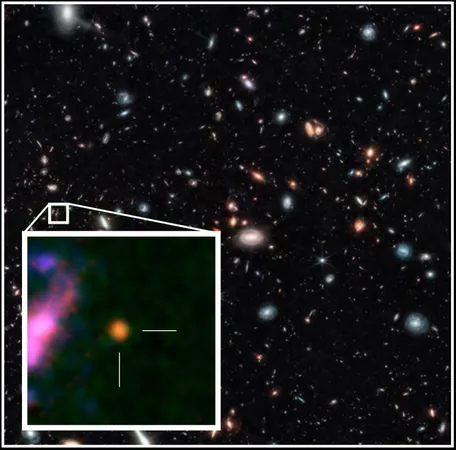
Groundbreaking Discovery: Webb and ALMA Unveil Secrets of Primeval Galaxy GHZ2
2025-01-16
Author: Siti
Astronomy's New Frontier
Astronomy has entered a new frontier, allowing scientists to peer back in time to observe the universe's earliest galaxies. This monumental advancement is made possible through cutting-edge observatories like the James Webb Space Telescope (JWST) and the Atacama Large Millimeter/submillimeter Array (ALMA). Together, these powerful instruments offer unprecedented insights into the formation and evolution of galaxies that shaped the cosmos as we know it.
Discovery of GHZ2
In a recently reported collaboration, an international team led by the National Astronomical Observatory of Japan (NAOJ) successfully detected atomic transitions from the galaxy known as GHZ2 (also referred to as GLASS-z12), an astonishing 13.4 billion light-years away—a record-breaking distance for such observations. This marks the very first time that emissions from galaxies exceeding 13 billion light-years have been captured, opening a new window into the properties of our universe's infancy.
Observational Techniques
Identified initially in July 2022 through the Grism Lens-Amplified Survey from Space (GLASS) using JWST's advanced Near-Infrared Camera (NIRCam), follow-up observations a month later by ALMA confirmed its remarkable spectrographic redshift of over z = 12. This stellar combination of techniques from the two observatories allowed scientists to gather vital information about one of the earliest and most distant galaxies ever observed.
Significance of the Observations
Lead astronomer Jorge Zavala from the East Asian ALMA Regional Center at NAOJ emphasized the significance of their endeavor. In a recent statement, he revealed, "Pointing the more than forty 12-meter antennas of ALMA alongside the 6.5-meter JWST for hours at what appeared to be an empty part of the sky, we successfully detected the signals from excited atoms, such as Hydrogen and Oxygen, from an era that had previously remained elusive."
Challenges of Observation
Understanding the physical characteristics of such distant galaxies is crucial for testing and refining our existing models of galaxy formation and evolution. Scientists employ advanced astronomical observations and spectroscopy techniques, which analyze the absorption and emission of light by matter, to detect specific chemical elements within these ancient celestial bodies. However, capturing data from these primeval galaxies presents significant challenges, given their immense distance from Earth.
Emission Lines and GHZ2's Characteristics
Notably, ALMA's observations identified emission lines linked to doubly ionized oxygen (O III), providing confirmation of GHZ2's existence just 367 million years after the Big Bang. By combining this data with observations from Webb's Near-Infrared Spectrograph (NIRSpec) and Mid-Infrared Instrument (MIRI), the researchers were able to construct a comprehensive understanding of GHZ2. Their findings suggest that this galaxy experienced vigorous bursts of star formation under conditions markedly different from more contemporary star-forming galaxies.
Metallicity and Stellar Density
Interestingly, GHZ2's metallicity—its abundance of heavier elements—is significantly lower than that observed in most studied galaxies. This observation corresponds well with scientific predictions regarding the early Universe, a time dominated by Population III stars composed primarily of Hydrogen and Helium. These massive, short-lived stars were the universe's first generation and exploded in supernovae, enriching their surroundings with heavier elements.
Mass and Structure
Recent data reveal that GHZ2 has a remarkable mass—several hundred million times that of the Sun—crammed into a relatively small region of around 100 parsecs (approximately 325 light-years). This high stellar density is reminiscent of globular clusters found in our own Milky Way, offering tantalizing clues about the formation of these ancient structures which have puzzled astronomers for decades.
Community Response and Future Prospects
Tom Bakx from Chalmers University remarked on the potential of this discovery, stating, "This study is the culmination of years of research aimed at unraveling the mysteries of early galaxies. The analysis of multiple emission lines has enabled critical testing of galaxy properties, showcasing the exceptional capabilities of ALMA through its dynamic collaboration with JWST."
Conclusion
As we continue to unlock the secrets of the early universe, studies like those of GHZ2 not only illuminate our cosmic history but also pave the way for future discoveries that will challenge our understanding of formation and evolution across vast timescales. This exciting collaboration between Webb and ALMA marks a pivotal moment in astronomy, inspiring future explorations into the enigmatic epochs that shaped our universe.



 Brasil (PT)
Brasil (PT)
 Canada (EN)
Canada (EN)
 Chile (ES)
Chile (ES)
 Česko (CS)
Česko (CS)
 대한민국 (KO)
대한민국 (KO)
 España (ES)
España (ES)
 France (FR)
France (FR)
 Hong Kong (EN)
Hong Kong (EN)
 Italia (IT)
Italia (IT)
 日本 (JA)
日本 (JA)
 Magyarország (HU)
Magyarország (HU)
 Norge (NO)
Norge (NO)
 Polska (PL)
Polska (PL)
 Schweiz (DE)
Schweiz (DE)
 Singapore (EN)
Singapore (EN)
 Sverige (SV)
Sverige (SV)
 Suomi (FI)
Suomi (FI)
 Türkiye (TR)
Türkiye (TR)
 الإمارات العربية المتحدة (AR)
الإمارات العربية المتحدة (AR)